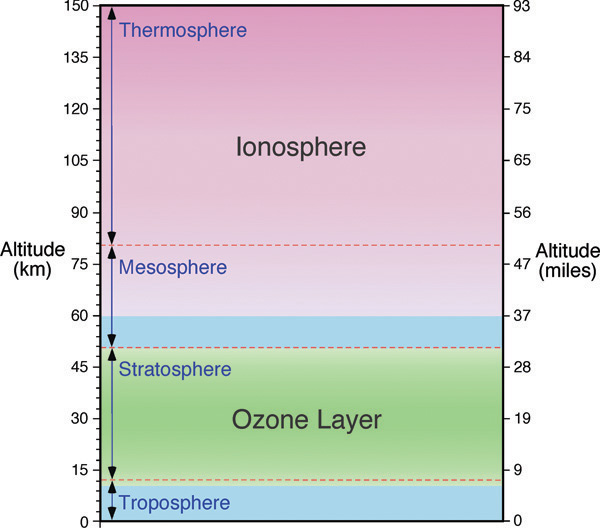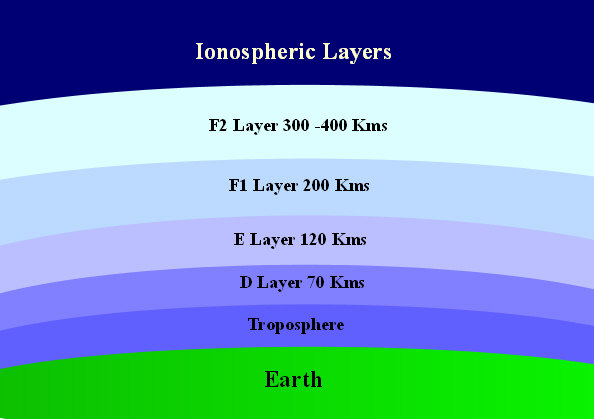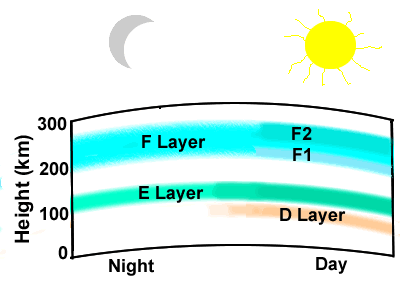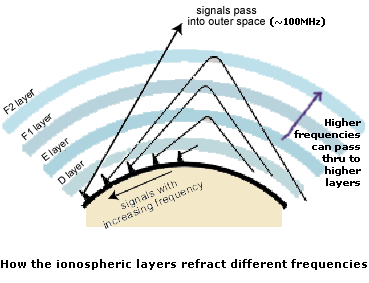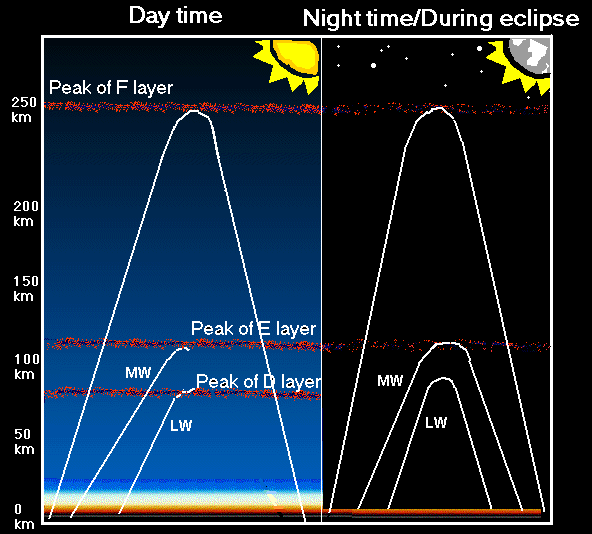Difference between revisions of "Ionosphere Layers"
(→D layer absorption) |
|||
| Line 36: | Line 36: | ||
The D layer absorbs HF frequencies below the 20-meter band. When the D layer dissipates after dark the lower frequencies are free to propagate by skywave or skip from the E and combined F layers. Because of this, ham radio operators use the higher HF bands of 20-meters and above during the daytime, and use the lower bands at night. | The D layer absorbs HF frequencies below the 20-meter band. When the D layer dissipates after dark the lower frequencies are free to propagate by skywave or skip from the E and combined F layers. Because of this, ham radio operators use the higher HF bands of 20-meters and above during the daytime, and use the lower bands at night. | ||
| − | While the 20-meter band and higher frequencies are not significantly attenuated by D layer energy absorption due to their smaller wavelengths, absorption at lower frequencies is usually too severe for DX. | + | While the 20-meter band and higher frequencies are not significantly attenuated by D layer energy absorption due to their smaller wavelengths, absorption at lower frequencies is usually too severe for DX. You can expect the 20-meter band to work to some extent both day and night. |
| + | |||
| + | * Frequencies above 20-meter up to MUF propagate better at day. | ||
| + | * Frequencies below 20-meter propagate better at night. | ||
=== angle of incidence === | === angle of incidence === | ||
Revision as of 23:20, 10 November 2015
The study of Sky Wave Propagation is an understanding of how RF is reflected by the various layers in the ionosphere. The Earth's ionosphere is part of the atmosphere around the planet. The ionosphere includes the thermosphere and parts of the mesosphere and exosphere. The ionosphere is a shell of electrons and electrically charged atoms and molecules around our planet that is ionized by solar radiation and influences radio propagation to distant places.
Contents
Layers that Impact Radio Communication
Scientists have divided the ionosphere into layers, with each layer having specific behavioral characteristics dependent on solar radiation.
There are three main regions within the ionosphere that impact RF communication
- D Region - Causes attenuation of RF signals, low frequencies are attenuated more than higher ones. Daytime only. Heavy ionization only results in absorption of MF and HF signals.
- E Region - HF radio signals are reflected here back towards the Earth and sometimes higher frequencies. Sporadic E is known for random 6-meter skip.
- F Region - Most forms of skywave propagation use the normal and cyclic ionization properties of this layer. Dual layer during the day, single at night.
Technically, the signals are not "reflected" as in a bounce, but they are bent around so that they return to the earth. So it is a "bend" rather than a "bounce." However, with that being said, scientists believe that the E layer is thin and dense and therefore may actually reflect rather than bend. The other other layers bend the wave.
There is also a C region below the others, but the level of ionization is so low that it does not have any effect radio signals and radio communications
Medium wave signals use ground propagation only during the day. The D region will absorb any signals it meets. At night the D region becomes invisible and the waves pass though to the E region. The E region reflects the signal back to the ground. Higher frequencies are not reflected by the E region. As frequency goes up, reflection goes down. E region reflection tends to make for shorter hops, meaning shorter distance DX.
When frequency is high enough it penetrates the E region it then may be reflected back by the F1 region, the first part of the F region of the ionosphere. Then with higher frequency F1 is penetrated and F2 is reflective. With each increase the next layer provides greater distance DX. The maximum skip distance for the E region is around 1550 miles and 3100 miles for the F2 region.
Signals can hop more than once. They can be bounced back to the ground, then reflected back up to the ionosphere once again for another hop, sometimes several more times. This is how DX is achieved from the other side of the globe. Water (the ocean) reflects the signal much better than land. The surface of the Earth and the D layer will weaken signal strength during each hop.
Several factors can contribute to signal fading, however, the lower the frequency the less fading will occur.
D layer absorption
In the low altitude D layer, the density of atmospheric particles is much greater than the density in the higher E and F layers. The D layer absorbs HF frequencies below the 20-meter band. When the D layer dissipates after dark the lower frequencies are free to propagate by skywave or skip from the E and combined F layers. Because of this, ham radio operators use the higher HF bands of 20-meters and above during the daytime, and use the lower bands at night.
While the 20-meter band and higher frequencies are not significantly attenuated by D layer energy absorption due to their smaller wavelengths, absorption at lower frequencies is usually too severe for DX. You can expect the 20-meter band to work to some extent both day and night.
- Frequencies above 20-meter up to MUF propagate better at day.
- Frequencies below 20-meter propagate better at night.
angle of incidence
If the angle of incidence is at that which the wave approaches the atmosphere straight up or nearly straight up, then it will not be bent back towards the earth, but instead shot off into space. The more angle to the horizon then the better the wave will bend and go back to the the ground in an apparent reflection.
Concerning the D layer and NVIS: Near Vertical Incidence Skywave (NVIS) technique causes lower HF signals to travel through the D layer in the shortest dimension, nearly at a right angle to the layer's spherical shell overhead. As a result, absorption of low frequency signals is minimized and NVIS regional communications is viable during daylight hours, particularly on the 40-meter band.
Sporadic E
Sporadic E or Es (E Skip) can allow VHF signals (30-300 MHz) to propagate over long distances via a reflection from the E layer. Sporadic E is generally classified into three types by, Mid-latitude, Equatorial and Auroral.
Sporadic E activity peaks predictably in the summertime in both hemispheres. In North America, the peak is most noticeable in mid-to-late June, trailing off through July and into August. From the month of May through to August there is noteworthy Sporadic E which can affect signals on all bands from 14-144MHz, although it is most commonly noticed on 28MHz and 50MHz. Openings for 2m may happen twice a year.
During sporadic E events, the E layer becomes heavily ionized in specific small thin areas, sometimes called clouds. This can last a few minutes or up to several hours. The effect is normally more pronounced with lower frequencies. Sporadic E propagation bounces signals off smaller "clouds" of unusually ionized atmospheric gas in the lower E region.
For a signal to propagate via Es a cloud of sufficient ionization must exist at the mid-path point. Just like the F layer, a sporadic E cloud will support a maximum frequency, above this frequency signals will not be reflected to earth. Because of the limited size of the cloud the areas where propagation occurs are also limited.
The cause of Es ionization is not precisely known. Maybe it has to do with wind shear in the upper atmosphere or storm activity. Sporadic E is easily detected by monitoring 28MHz and 50MHz.
Sunspot Cycle
Solar activity is directly related to radio frequency reflectivity in the ionosphere. As solar activity increases, more sunspots emerge on the sun's surface. The sunspots themselves are not what charges up our ionosphere, they are merely an indication that is what is going on. The 11-year sunspot cycle is typical and each cycle may have more or less significant ionospheric impact.
The MF and HF regions of the radio spectrum are most impacted by ionosphere charge and the solar sunspot cycle. During periods of high sunspot cycles there is an increase in the skip distance of the skywave at night.
MUF
Maximum Usable Frequency. Operational MUF is the highest frequency you can operate with your specific working conditions and equipment to communicate with another specific station. MUF is dependent on ionospheric radio propagation. Frequencies including the Critical Frequency; Lowest Usable Frequency, LUF; Maximum usable frequency, MUF; and the Optimum Working Frequency, OWF are all relevant when determining which frequencies will provide the best performance for a short wave radio, and HF 2-way radio communications. Know your international / DX beacons that you can tune to so that you can determine the current MUF.
The MUF is a moving target. It depends on ionization with the factors mentioned previously. Above that MUF threshold the RF is lost to space. Just below it waves are subject to scatter effect.
The MUF is typically in the HF range. It is infrequent that the MUF will elevate up to the VHF range, and rare for it to be in the UHF range.
Frequencies below 10 MHz travel most efficiently by skywave at night. Frequencies above 10 MHz travel better during the day.
CB Radio Skip Shooting
Citizens Band radio skywave propagation characteristics are going to behave like and available when 10-meter ham band skip occurs. CB radio operators tend to use different language or lingo than licensed ham radio operators. CB operators like to call the practice of DX'ing on 11-meter by the term "skip shooting."
Some CB operators use special directional antennas such as a horizontal beam antenna sending the signal to the ionosphere at an angle which helps them to make distant contacts or DX. Technically this activity is forbidden by the FCC on CB. However, operators using legal power limits are not actively sought out with any punitive action.
Part 95, Subpart D of the FCC rules. It is illegal to engage in, or attempt to engage in communications with any station more than 155.3 miles from your location
There is no law against listening. Any CB radio owner may listen for DX (DX hunting) with their CB radio during periods of skip activity without breaking any regulation. CB operators attempting to communicate via skip shooting tend to use SSB (single side band) capable transceivers. If you are interest in listening you will need a receiver that is capable of tuning SSB. Most shortwave radios do only AM. Think of SSB as one side of AM less the carrier.
Standard 40 channel CB radios are AM only at 4 watts legal transmit power. SSB capable CB radios can transmit up to 12 watts on SSB while still being capable of 4 watts on AM, using the upper or lower side band USB or LSB, legally.
